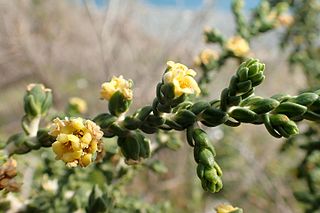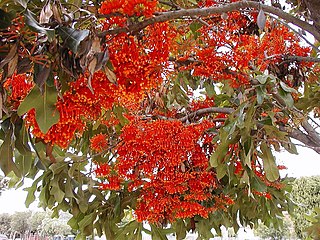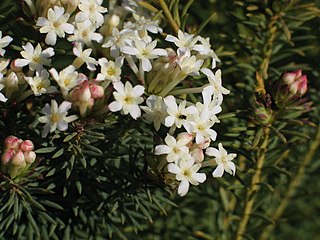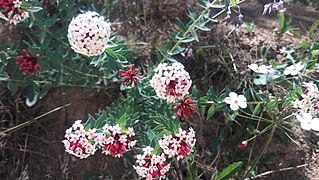Gonystylus is a southeast Asian genus of about 30 species of hardwood trees also known as ramin, melawis (Malay) and ramin telur (Sarawak).

The Thymelaeaceae are a cosmopolitan family of flowering plants composed of 50 genera and 898 species. It was established in 1789 by Antoine Laurent de Jussieu. The Thymelaeaceae are mostly trees and shrubs, with a few vines and herbaceous plants.

Stenocarpus is a genus of about 25 species of woody trees or shrubs, constituting part of the plant family Proteaceae.
New Caledonia wattled bat(Chalinolobus neocaledonicus) is a species of vesper bat in the genus Chalinolobus. It is found only in New Caledonia.

Acridocarpus is a genus of plant in family Malpighiaceae. They are native to Arabia and tropical and subtropical Africa, with one species in New Caledonia.
Gnidia socotrana is a species of plant in the Thymelaeaceae family. It is endemic to Yemen. Its natural habitats are subtropical or tropical dry forests and subtropical or tropical dry shrubland.

Gnidia is a genus of flowering plants in the family Thymelaeaceae. It is distributed in Africa, Madagascar, Arabia, India, and Sri Lanka; more than half of all the species are endemic to South Africa. Gnidia was named for Knidos, an Ancient Greek city located in modern-day Turkey.
Solmsia is a genus containing one or two species of flowering plants belonging to the family Thymelaeaceae. It is endemic to New Caledonia. The genus was named to honor Hermann zu Solms-Laubach by Henri Ernest Baillon. It is related to Arnhemia, Deltaria, Gonystylus and Lethedon.
Oncotheca is a genus of tree endemic to New Caledonia. There are two species, Oncotheca balansae and Oncotheca humboldtiana.
Melaleuca gnidioides is a shrub in the myrtle family Myrtaceae and is endemic to the south of Grande Terre, the main island of New Caledonia. It is one of only a few members of its genus to occur outside Australia and is a small shrub with heads of white flowers which turn pink with age.
Pimelea gnidia is a species of small shrub in the family Thymelaeaceae. It is endemic to New Zealand. According to the New Zealand Threat Classification System (NZTCS), it is not threatened as of 2012.

Loxodiscus coriaceus is a species of shrubs in the family Sapindaceae. It is endemic to New Caledonia and the only species of the genus Loxodiscus. Its closest relatives are Cossinia, Diplopeltis, Dodonaea and Harpullia.
Daenikera corallina is a plant parasite species in the Santalaceae family. It is endemic to New Caledonia and the only species of the genus Daenikera. Its closest relative is Amphorogyne, also endemic to New Caledonia.
Mangenotiella stellata is a species of shrub in the family Primulaceae. It is endemic to New Caledonia and the only species of the genus Mangenotiella.
Lethedon is a genus of shrubs in the Thymelaeaceae family from Australia and New Caledonia. It is related to Arnhemia, Deltaria, Gonystylus and Solmsia.

Stellera is a genus of flowering plant in the family Thymelaeaceae, with a single species Stellera chamaejasme found in mountainous regions of Central Asia, China, Siberia and South Asia. S. chamaejasme is a herbaceous perennial plant with heads of white, pink or yellow flowers, grown as an ornamental plant in rock gardens and alpine houses, but considered a weed playing a rôle in the desertification of grasslands in parts of its native range. Like many others of its family, it is a poisonous plant with medicinal and other useful properties.
Diarthron is a genus of flowering plant in the family Thymelaeaceae. The precise limits of the genus are uncertain. When broadly circumscribed to include Dendrostellera and Stelleropsis, it consists of annual and perennial herbaceous plants and small shrubs, with reddish, white or green flowers lacking petals, and is found in central and south-west Asia and south-east Europe.

Struthiola striata is a rounded, heather-like shrub of up to 1.5 m (4.9 ft) high that is assigned to the Thymelaeaceae family. It has small assending leaves on long straight branches, with cream, soft yellow or pinkish flowers in spikes, each of which consist of a tube of about 1 cm (0.39 in) long with 4 oval sepal lobes and 4 yellow alternating petal-like scales. It is sometimes called ribbed capespray or featherhead in English and roemenaggie, katstertjie or veërtjie in Afrikaans. It grows on coastal flats and foothills in the Western Cape province of South Africa.
Struthiola tetralepis is a willowy shrublet of up to 30 cm (0.98 ft) high that is assigned to the family Thymelaeaceae. It has long straight branches that are initially hairy and are covered in leaves pressed against them. These leaves are small, overlapping, lance-shaped, scharply pointed, have a regular row of hairs along the margins, and 3-5 veins are visible on the outward facing surface. It has initially greenish yellow, later reddish brown flowers, each of which consists of a tube of about 1 cm (0.39 in) long with 4 lance-shaped, pointed sepal lobes and 4 yellow alternating petal-like scales. It flowers between October and February. It can be found in the southwest of the Western Cape province of South Africa. It is sometimes called cross capespray in English.






